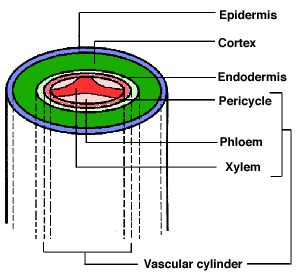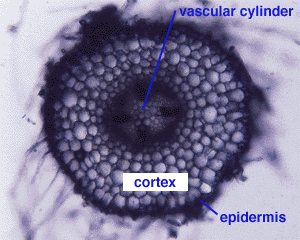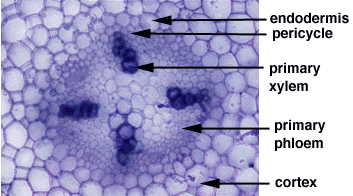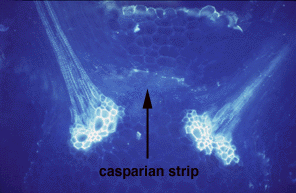 The basic organization of roots is in layers of cylinders. In roots exhibiting only primary growth, the outermost cylinder consists of the dermal layer which is made up of epidermal cells. There are also root hairs which are unicellular extensions in the epidermis that function in the uptake of water and other nutrients. The next cylinder is a layer of ground tissue called the cortex. It is made up of parenchyma cells. The next layer, the endodermis, which is the innermost layer of the cortex, is distinct from the rest of the cortex for a few reasons. The most important distiguishing factor is the casparian strip, a layer of a waxy substance called suberin that has been embedded into the endodermal cell wall.The casparian strip prevents the passage of water and other molecules through the endodermis via an apoplastic pathway. Right inside of the endodermis is the pericycle, a layer of meristematic cells that functions in the formation of lateral roots, the vascular cambium, and the cork cambium. The final cylinder consists of vascular tissue that functions in the transport of water, sugars, and other nutrients up and down the plant.
The basic organization of roots is in layers of cylinders. In roots exhibiting only primary growth, the outermost cylinder consists of the dermal layer which is made up of epidermal cells. There are also root hairs which are unicellular extensions in the epidermis that function in the uptake of water and other nutrients. The next cylinder is a layer of ground tissue called the cortex. It is made up of parenchyma cells. The next layer, the endodermis, which is the innermost layer of the cortex, is distinct from the rest of the cortex for a few reasons. The most important distiguishing factor is the casparian strip, a layer of a waxy substance called suberin that has been embedded into the endodermal cell wall.The casparian strip prevents the passage of water and other molecules through the endodermis via an apoplastic pathway. Right inside of the endodermis is the pericycle, a layer of meristematic cells that functions in the formation of lateral roots, the vascular cambium, and the cork cambium. The final cylinder consists of vascular tissue that functions in the transport of water, sugars, and other nutrients up and down the plant.
|
 The basic organization of roots is in layers of cylinders. In roots exhibiting only primary growth, the outermost cylinder consists of the dermal layer which is made up of epidermal cells. There are also root hairs which are unicellular extensions in the epidermis that function in the uptake of water and other nutrients. The next cylinder is a layer of ground tissue called the cortex. It is made up of parenchyma cells. The next layer, the endodermis, which is the innermost layer of the cortex, is distinct from the rest of the cortex for a few reasons. The most important distiguishing factor is the casparian strip, a layer of a waxy substance called suberin that has been embedded into the endodermal cell wall.The casparian strip prevents the passage of water and other molecules through the endodermis via an apoplastic pathway. Right inside of the endodermis is the pericycle, a layer of meristematic cells that functions in the formation of lateral roots, the vascular cambium, and the cork cambium. The final cylinder consists of vascular tissue that functions in the transport of water, sugars, and other nutrients up and down the plant.
The basic organization of roots is in layers of cylinders. In roots exhibiting only primary growth, the outermost cylinder consists of the dermal layer which is made up of epidermal cells. There are also root hairs which are unicellular extensions in the epidermis that function in the uptake of water and other nutrients. The next cylinder is a layer of ground tissue called the cortex. It is made up of parenchyma cells. The next layer, the endodermis, which is the innermost layer of the cortex, is distinct from the rest of the cortex for a few reasons. The most important distiguishing factor is the casparian strip, a layer of a waxy substance called suberin that has been embedded into the endodermal cell wall.The casparian strip prevents the passage of water and other molecules through the endodermis via an apoplastic pathway. Right inside of the endodermis is the pericycle, a layer of meristematic cells that functions in the formation of lateral roots, the vascular cambium, and the cork cambium. The final cylinder consists of vascular tissue that functions in the transport of water, sugars, and other nutrients up and down the plant.


